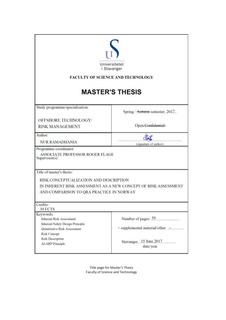| dc.contributor.advisor | Flage, Roger | |
| dc.contributor.author | Ramadhania, Nur | |
| dc.coverage.spatial | Norway | nb_NO |
| dc.date.accessioned | 2017-09-21T11:58:17Z | |
| dc.date.available | 2017-09-21T11:58:17Z | |
| dc.date.issued | 2017-06 | |
| dc.identifier.uri | http://hdl.handle.net/11250/2456027 | |
| dc.description | Master's thesis in Risk management | nb_NO |
| dc.description.abstract | In 2009, Shariff and Leong [1] introduced a new concept named as Inherent Risk Assessment (IRA). The concept integrates quantitative risk analysis and to a process design simulator called HYSYS aiming to provides essential data as early as possible so that modification based on inherent safety principles can still be incorporated into the design. By doing so, the evaluation of inherent risk can be easier and faster. Thus, an inherently safer design can be obtained.
On the other hand, in Norway, Quantitative Risk Assessment (QRA) studies has been extensively implemented in the petroleum industry for more than two decades. In performing the QRA, a guideline called NORSOK Standard Z-013 Risk and Emergency Preparedness Assessment [2] is utilized by the Norwegian petroleum industry and this standard is regarded as the most detailed standard. QRA is regarded as a well-establish and well-proven method in risk assessment.
Based on the key facts related to the risk assessment methods described above, it is interesting to understand further about how is risk conceptualized and described in Inherent Risk Assessment and NORSOK Z-013 [2] as the guideline of QRA practice in Norway compared to uncertainty-based risk conceptualization. Another interesting point is to discuss the key differences of Inherent Risk Assessment compared to Quantitative Risk Assessment practice in Norway based on NORSOK Z-013 [2].
In this work, several fundamental issues found in IRA, which most of them appears as disadvantages when compared to QRA in Norwegian petroleum industry. The first issue is the lack of attention given to uncertainty aspect as a consequence of Shariff and Leong [1] seems to have a mixed up understanding of probability and uncertainty. The second issue related to the risk picture presentation where ALARP region is excluded because the ALARP principle is seen can only be exclusively applied to the add-ons risk-reducing measures. The third issue the ‘mechanistic’ approach demonstrated by the study cases where the assessment is focused on the satisfying the risk tolerable limit. The other issues are related to the fact that IRA is designated to be performed in the preliminary design stage so that the implementation of inherently safer design principles can only be optimized on a fix design concept and there is a need for another risk assessment as complementary to assessed risk in the following stages.
In comparison, QRA in Norwegian petroleum industry put a consideration of uncertainty aspect in its study and NORSOK Z-013 [2] covered the introduction of ALARP principle and evaluation even tough it is part of risk treatment which is out of the standard’s scope. Moreover, QRA studies can be performed as early as concept selection phase so it has the greatest opportunity to give influence to the design and it does not need a complementary risk assessment.
The only notable advantage of IRA compared to QRA in Norway is the high integration of the risk assessment in the form of quantitative risk analysis to a process design simulator. The integration allows for the automation in the knowledge transfer between the designers and the risk assessor. Therefore, the risk level can be obtained faster compared to typical QRA studies.
The practice in Norwegian petroleum industry shows that by performing QRA thoroughly and carefully in different phases of the project, all risk in the design will be assessed since the earliest phase and the need for a complementary risk assessment can be eliminated. | nb_NO |
| dc.language.iso | eng | nb_NO |
| dc.publisher | University of Stavanger, Norway | nb_NO |
| dc.relation.ispartofseries | Masteroppgave/UIS-TN-IØRP/2017; | |
| dc.subject | ALARP Principle | nb_NO |
| dc.subject | inherent risk assessment | nb_NO |
| dc.subject | inherent safety design principles | nb_NO |
| dc.subject | quantitative risk assessment | nb_NO |
| dc.subject | risk concept | nb_NO |
| dc.subject | risk description | nb_NO |
| dc.subject | risikostyring | nb_NO |
| dc.subject | risk management | nb_NO |
| dc.title | Risk Conceptualization and Description in Inherent Risk Assessment As A New Concept Of Risk Assessment and Comparison to QRA Practice In Norway | nb_NO |
| dc.type | Master thesis | nb_NO |
| dc.subject.nsi | VDP::Samfunnsvitenskap: 200 | nb_NO |
